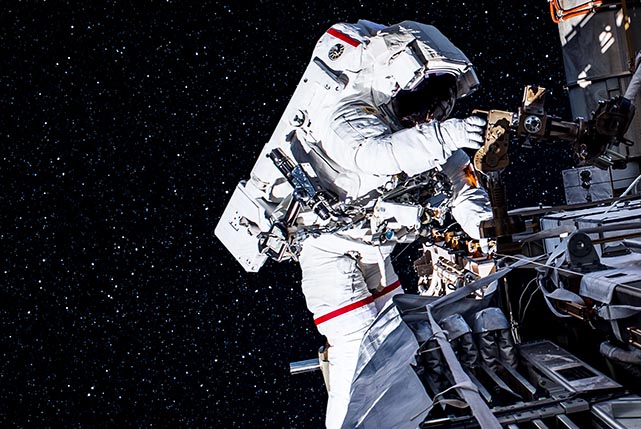Space exploration involves operating complex and unique equipment in extreme environmental conditions. The capability for collaborative problem solving in space was instrumental in Apollo-13 and Salyut-7 rescue missions as well as in numerous extra vehicular activities at the International Space Station (ISS). However, to go beyond the low Earth orbit, the currently prevailing method of repair "by-replacement" must be changed to the "deep-repair" due to the mass limit of spares supply. Coupled with the equipment complexity, small crew, and long flight duration, remote collaboration will become the critical feasibility and safety technology of future human exploration missions.
The development of the remote collaboration concept and the foundations of the reliable and secure telecommunication protocol behind POINTR started in 2008. VTT Technical Research Centre of Finland, Thales Alenia Space Italy (TAS-I), and the European Space Agency (ESA) played an important role in supporting the creation and commercialization of this technology. The initial prototypes of projected augmented reality system "AstroVAR" to be mounted on the space suit helmet were demonstrated to TAS-I and Altec space experts in December 2012. The principle investigators of the project - Dr. Boris Krassi and Sauli Kiviranta - received practical support from VTT and TAS-I management to commercialize the technology leading the foundation of Delta Cygni Labs as a spin-off company in June 2013.
During the first year of operation, DCL miniaturized "AstroVAR" to include a powerful mobile computer, laser projector, network connectivity, autonomous power, passive cooling, augmented reality software in a stand-alone unit of the size of an external hard drive. This was a major technical achievement. Compared to Sony Xperia Touch projector released four years later, AstroVAR had superior specifications: 2x smaller, 1/3 lighter, producing sharp image at any distance visible in bare daylight.
The feedback from space experts and astronaut trainers suggested that while remote collaboration would be very promising for future space products, it already could have numerous potential applications on Earth in the environments as challenging as space, for example, maritime, off-shore, mining, rescue. This helped DCL to form the strategic roadmap from gaining maturity in terms of functionality, performance, operations on the ground, to later becoming the key feasibility factor in Lunar and Martian exploration.
Here POINTR was born in January 2015. POINTR is a video based human-to-human remote collaboration Software-as-as-Service powered by augmented reality. It provides capability for deep equipment repair, off-nominal maintenance, complex installation, and training on ground today and in space tomorrow. Since then the company was grown by combining private and public investment: the core R&D in Finland, sales and marketing team, IPR protection, subsidiary in Germany, and branch partner offices in LATAM, USA, and Japan with 40 professionals around the globe. Read more about POINTR
POINTR is based on XRTC telecommunication protocol. It was originally developed to enable communication between European Space Agency sites in different European countries without the need to establish VPN or open any inbound ports. From the very beginning, the solution had to meet the absolute data security requirements: same level as governmental and military projects. The development therefore followed the Security by Design approach. This means that the security of the protocol does not depend on correctness of the firewall settings. Simple and network preserving. This development was supported by the European Space Agency funding. With a wider deployment of 5G, XRTC protocol will make UDP and its derivatives like WebRTC and QUIC obsolete in all applications involving soft-real time voice and video streaming, AR, VR, IoT, drone control and immersive telepresence. Read more about XRTC
